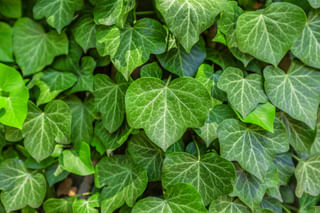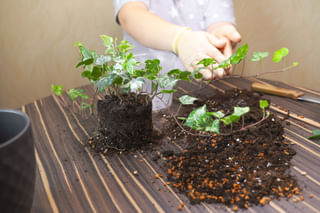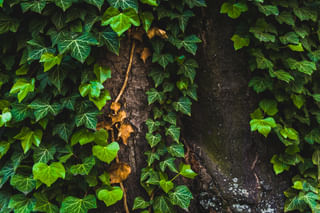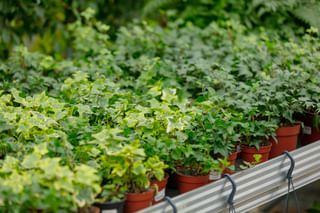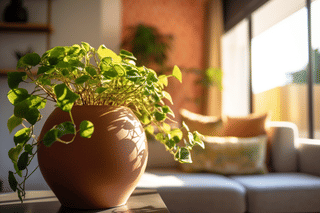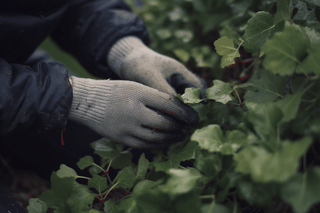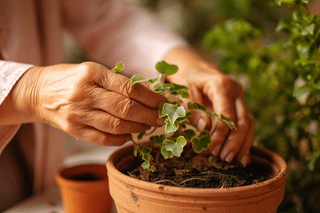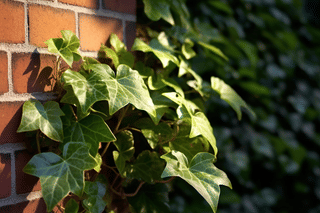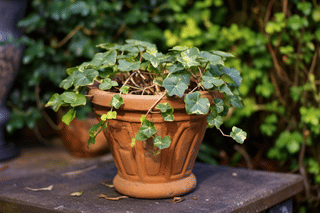How to take care of an English Ivy
The English Ivy is a plant that thrives outdoors, but can also grow indoors. It's a divisive plant, as you either hate it, see it as a pest, and just can't get rid of it or you love it and enjoy how it makes even the toughest place in your garden green. In this plant care guide, we're going to find out how you can best take care of your English Ivy!
The English Ivy is a divisive plant: you either hate it and see it as a plant that you just can't get rid of, or you love it and love how green it makes your garden or home look. It's not just a plant that takes over your garden quite quickly, it also needs special care when you're trimming it to make it more manageable.
If you love this plant, you're not alone! I love this plant because it grows in even the toughest places in your garden. This seemingly indestructible plant does need specific growing environments because even the toughest plant has its limits. In this plant care guide, we're going to explore how to take care of your English Ivy. These are the topics we're going to look at in this plant care guide:
Let's get started and figure out how we can set up your English Ivy for success and give it the best chance to make your garden or home a little greener. We'll also make sure to highlight what to avoid when you're taking care of an English Ivy.
This plant needs little to no attention if you're growing it outdoors, but does need a lot more attention if you're growing it in your home.
Watering your English Ivy
Watering your (house)plants is often the most important thing to get right to keep your plants healthy. Since you can grow your English Ivy indoors and outdoors, we'll look at how you can best water your English Ivy when it's planted indoors and when it's planted outdoors.
Your English Ivy loves moisture but doesn't like to sit in a puddle of water. Further in this plant care guide, we'll look at the right soil you'll need to keep your Ivy healthy. For now, we'll look at how you can best water your English Ivy when it's growing indoors.
Watering your English Ivy indoors
When you've planted your English Ivy in a pot indoors, and you want to keep your Ivy healthy, it's important to keep the soil moist at all times. It's also important to realize there is a difference between moist soil and wet soil.
- When your soil is moist, it means that your soil has soaked up all the moisture it can hold, but there is no puddle of water at the bottom of the pot.
- Wet soil has soaked up so much moisture that it's dripping the excess water to the bottom of the pot. This puddle of water at the bottom of the pot is the most common cause of root rot, so it's best to avoid it altogether.
The easiest way to properly water your Ivy is to use a pot with drainage holes. When you water your plant and the soil can no longer hold the water, it'll sink to the bottom of the pot. The drainage hole helps to get rid of this excess water. This helps to prevent root rot and keeps your Ivy healthy in the long term.
The best time to water your Ivy indoors is when the soil is dry to the touch, but not completely dry yet. On average, this means you should water your English Ivy once per week.
Watering your English Ivy outdoors
We already know that the English Ivy loves to grow in soil that's moist all the time. This is important for houseplants, but also if you grow your Ivy outdoors. If Ivy naturally grows in your home country or you live in a country that receives lots of rain, you won't have to pay too much attention to watering your English Ivy, because the rain will automatically water your plant properly.
The only thing you'll have to think about is droughts. If it hasn't rained in 5-7 days, it's good to water your Ivy yourself. This will keep your plant healthy and happy during the dry days.
Watering your English Ivy in the winter
In the winter, when your English Ivy goes dormant, you won't have to water your plant as often as you did in the spring and summer.
In the winter, your plant is dormant and it's recovering from the growing season. It won't need as many nutrients and won't grow, so you should water your Ivy less often. On average, you should water your English Ivy half as much as you did in the spring and summer. For outdoor plants, this means you won't have to water your Ivy at all and for your Ivy that's growing indoors, you'll only have to water it once every 14 days.
Sunlight for your English Ivy
The second most important thing for your plant is sunlight exposure. When you place your English Ivy in a spot that has the perfect sunlight exposure for your plant, you'll see your plant become happier and healthier.
Your English Ivy grows best in a spot that has indirect sunlight exposure. Indirect sunlight means that your plant doesn't get any direct sunlight on its leaves, whether this is outdoors or through a window. Direct sunlight will leave burn marks on your plant or make its environment too warm for it to be happy.
The perfect place for your English Ivy that's growing indoors is a spot in the middle of a room with a south or west-facing window. If you're looking for the best place for your Ivy outdoors, choose a spot that's in the shade most of the day. A little bit of sunlight is no problem, but it doesn't do well in a spot that's in bright sunlight all day long.
If you have a spot outdoors that's in the shade most of the day and also out of the wind, you found the perfect spot for your Ivy. The plant can easily survive freezing temperatures, but it doesn't do well in strong winter winds.
Sunlight exposure for your English Ivy in the winter
In the winter, the sun isn't as strong and lower in the sky during the day. There is less sunlight coming in through the windows and your house is darker during the day.
To help your Ivy indoors, you should move it closer to windows to give it some extra sunlight exposure. During the growing season, this sunlight is often too harsh, but it's fine during the winter. If you're growing your Ivy outdoors, there is nothing you need to do.
Can English Ivy tolerate low light conditions?
English Ivy is known for being one of the most versatile and adaptable plants when it comes to lighting conditions. While it does prefer bright, indirect sunlight, it can still thrive in low light conditions, making it a great option for offices, bathrooms, and other spaces with limited natural light.
English Ivy is even considered a top air-purifying plant and can filter out common indoor air pollutants like formaldehyde and benzene. So not only will it bring some greenery and vitality to your space, but it can also improve your air quality!
When it comes to caring for your English Ivy in low light, there are a few things to keep in mind. First of all, be sure not to overwater it as with any plant, too much water can cause root rot and other issues. Instead, let the soil dry out slightly between waterings.
Another thing to keep in mind is that while English Ivy can tolerate low light, it will still benefit from some exposure to brighter light. You can do this by moving the plant to a sunnier spot for a few hours once a week or so, or by using a grow light.
Temperature requirements
For an English Ivy to truly thrive, it's important to make sure that its environment is good for its growth. One important part of this is the temperature.
Ideally, English Ivy likes to grow in an environment with a temperature range of 15 to 24 degrees Celsius (60-75 F). This range makes sure that the plant is not exposed to extreme temperatures that could slow its growth. During the winter months, it's especially important to keep the plant away from cold drafts and windows that could cause the temperature to drop too low.
It's worth noting that English Ivy is a tough plant that can tolerate some temperature changes, but keeping it within the recommended range will prevent stress on the plant and keep it growing steadily. Also, keeping the plant in a slightly cooler environment can help prevent pest problems and keep the foliage looking vibrant and healthy.
Temperature for your English Ivy outdoors
If you're planning on growing English ivy outdoors, it's important to make sure that the temperature range is suitable for its growth and development. The ideal temperature range for English ivy that grows outdoors is between 10 and 21 degrees Celsius (50 to 70 F).
As we said before, English Ivy is a resilient plant that can tolerate a range of temperatures outside of the ideal range. If you live in a climate with freezing winters, you'll notice that the plant dies off here and there in the winter. This is not a problem though, as it will recover in the spring.
Humidity requirements
English Ivy is a tough plant that can tolerate a range of humidity levels. However, it does prefer a slightly more humid environment than some other houseplants.
Ideally, English Ivy should be kept in an environment with humidity levels between 40% and 60%. If you have your English Ivy indoors, you can use a humidifier near the plant, misting the leaves with water, or placing the pot on a tray of water and pebbles.
It's important to note that while English Ivy can tolerate lower humidity levels, too much dry air can lead to brown and crispy leaves. On the other hand, too much moisture can lead to fungal growth and other issues.
Maintaining humidity for your English Ivy outdoors
It might sound a little silly to even mention trying to control the humidity for your plant outdoors, but it's quite easy to do with a few tips! If your English Ivy is outdoors, it can be challenging to maintain the perfect humidity level because outdoor conditions are unpredictable. Here are a few tips to help you do that:
You can provide shade for your English Ivy to protect it from the sun's intense heat. This will help to prevent too much water from evaporating and maintain humidity levels. Another way to help your Ivy is to create a microclimate for your English Ivy by surrounding it with other plants that can hold moisture in their leaves and hold a lot of moisture in the soil. This will keep the air around your English Ivy humid and moist. Ideal plants for this purpose are Alchemilla mollis or Sedum carpet plants. These protect the ground from drying out as well.
If all else fails, you can also mist your English Ivy with lukewarm water once or twice a day with a gardening hose. This will make sure the plant's leaves stay moist and keep the humidity levels consistent. If you choose to do this, do so in the early morning to avoid the water evaporating right away.
Can English Ivy tolerate air conditioning or heating vents?
English Ivy is a tough plant and can tolerate air conditioning and heating vents, but it's important to keep a few things in mind. If the vent blows directly onto the plant, it can cause excessive drying of the leaves and soil, which can eventually lead to plant death. To prevent this issue, it's best to avoid placing your English Ivy near vents that blow directly onto the plant.
Air conditioning and heating vents dry out the air in your house, so if your English Ivy is close to these units, make sure to check the plant a little more often if it needs to be watered. It's a good idea to mist your plant regularly or place a tray of water near the plant to help maintain the moisture levels.
The perfect soil for your English Ivy
We've already learned a lot about watering and sunlight exposure, so let's move on to the next most important thing about taking care of your English Ivy: Soil.
Earlier in this plant care guide, we've discovered that your English Ivy likes the soil to become dry to the touch, but stays moist most of the time. So we'll need soil that can hold onto moisture for a few days and also doesn't compact over time.
Soil that gets watered a lot, like the soil of your English Ivy, will want to compact over time. But we can add stuff to the soil to keep the structure intact and help the oxygen flow to your ivy roots freely. This helps to prevent root rot and keeps your plant healthy.
The best type of soil would be a mix of potting soil to hold onto moisture for a few days, but also perlite/pumice/rocks. These rocks will help to prevent the soil from compacting and also improve drainage quite a bit. Smart Gravel is also a great option to add to your soil, because it'll improve drainage and get rid of any of the excess water quickly.
Fertilizing your English Ivy
Your English Ivy is a fast-growing plant and needs a lot of nutrients to stay healthy while growing this fast. Your Ivy gets these nutrients from the soil. However, you'll also need to supplement the nutrients in the soil with fertilizer.
You should fertilize your English Ivy once every 14 days in the spring and summer to help promote growth and keep the plant happy. The easiest way to fertilize your plant is to add liquid fertilizer to the water you'll use when watering your plant. This fertilizer gets absorbed more quickly than any other fertilizer.
If you want a more hands-off approach, you can also use slow-release fertilizers like fertilizing sticks. You can read more about which fertilizer is best in What is the best type of fertilizer for houseplants?.
Fertilizing your English Ivy in the winter
In the winter, when your English Ivy is asleep and it's not growing (as quickly), you shouldn't fertilize it at all. Your English Ivy won't use the fertilizer and it'll stay behind in the pot or the ground. This will make the soil salty and that will make it a tough place for your plant to grow.
Is your English Ivy toxic for pets?
If you have pets or children, you need to think about whether the plants you buy can be harmful to your loved ones. Unfortunately, the English Ivy is very toxic for pets, but also for yourself. The sap will cause rashes on your skin on contact and will cause stomach issues when ingested (both people and pets). That's why it's also very important you cover your skin when you're pruning this plant, as it's very easy to get the sap on you.
If you couldn't tell, I'm speaking from personal experience here. It takes about 3-5 days for the rashes to go away again, so it's best to wear a long-sleeve shirt and gardening gloves when handling this plant.
How often should I prune my English Ivy?
To make sure that your Ivy stays healthy and vibrant, it's important to prune it regularly. The frequency of pruning depends on several factors. Let's have a look!
The growth rate of your English Ivy is the most important factor to consider when deciding how often to prune it. If your plant is growing quickly, then it may need to be pruned more often than if it's growing at a slower rate. This is because rapid growth can lead to thicker foliage and branches, which can eventually become too heavy for the plant to support.
The size and shape of your English Ivy can also determine how often you should prune it. If you want your ivy to have a particular shape, then you may need to prune it more often to maintain that shape. Similarly, if your Ivy is getting too large for its current location, you may need to prune it more frequently to keep it in check.
Generally, you should prune your English Ivy two to three times per year, typically in the spring and fall. This will help to promote healthy growth and maintain its shape and size. However, if you notice any dead or diseased branches, you should remove them immediately to prevent the problem from spreading.
How do I propagate (multiply) my English Ivy?
Propagating your plants helps you to get more of the same plant for free! English Ivy is quite an easy plant to propagate and this can be done using several different methods.
In this section, I will explain how to successfully propagate English Ivy, so that you can grow even more of this lovely plant. You can propagate your English Ivy in several methods, including stem cuttings, layering, or through seeds. When you're cutting this plant, make sure to cover your skin!
Stem cuttings
Begin by selecting a healthy stem from your existing vine that is at least six inches long, and make a clean cut just below a leaf node. Make sure to use a pair of clean shears or scissors. Remove the lower leaves along the stem, leaving two or three sets of leaves at the top. Dip the cut end of the stem in rooting hormone, and then plant it in a container filled with a well-draining soil mix.
Keep the soil moist, but not overly wet, and place the container in a bright location, but out of direct sunlight. Within a few weeks, you should see new growth emerging from the planted stem. At this point, you've successfully propagated your Ivy.
Layering
This method involves bending a stem down to the soil and burying it slightly, making sure it is still attached to the parent plant. Place a small rock over the buried part of the stem to encourage rooting, and keep the soil moist until new growth emerges. Once roots have formed, you can cut the new plant away from the parent, and transplant it to a new container or location.
Through seeds
Propagation through seeds is also possible, but this method can be more challenging, as English Ivy seeds require specific conditions to germinate successfully. For this method, you will need to collect seeds from existing flowers/berries and plant them in a container with a well-draining soil mix.
Cover the container with a plastic bag to trap moisture and warmth, and place it in a warm, bright location. Seeds can take several weeks to germinate, so be patient and keep the soil moist during this period.
How often should I repot my English Ivy?
One of the common questions that plant enthusiasts often ask is whether their English Ivy plant needs repotting and how often it should be done. The answer to whether or not to repot the English Ivy plant depends on the size of the pot, the growth rate of the plant, and the potting soil.
Usually, you should repot the English Ivy once every two to three years or when the roots have outgrown the pot and are beginning to show signs of overcrowding. Signs of overcrowding include roots growing through the drainage holes or the plant becoming top-heavy and leaning to one side.
When repotting, it's recommended to use a well-draining potting mix and a pot that's one size larger than the current one to give the roots more room to grow. It's important to select a pot with drainage holes to prevent waterlogging that can lead to root rot.
If your English Ivy plant is not showing signs of overcrowding, you can still refresh the potting soil every year using the top-dressing technique. Top-dressing means you remove the top layer of soil and replace it with fresh potting soil while leaving the plant in the same pot. This top layer will spread nutrients to the roots when you water your plant.
Pests and diseases
When it comes to English Ivy, there are a few pests and diseases that you should keep an eye out for to keep your plant healthy and thriving. When it comes to identifying common pests in your garden, spider mites, mealy bugs, and scale insects are definitely among the top troublemakers. However, with a little bit of knowledge and observation, it is possible to spot these pests and take appropriate measures before they cause any permanent damage to your plants.
Spider mites
One common pest is spider mites, which are tiny insects that can suck the sap from the leaves and cause them to turn yellow or brown. To prevent spider mites from infesting your English Ivy, try regularly misting the plant and keeping the humidity levels high.
The tell-tale signs of spider mite infestation include web-like structures on the underside of leaves, discoloration, stippling, and stunted growth. To confirm if your plants are indeed under attack from spider mites, you can use a magnifying glass to look for the mites themselves, which are usually less than 1mm long and range from pale green to red. You can also perform a tape test, where you wrap a piece of transparent tape around a leaf and observe if any mites or brown spots stick to it.
Mealybugs
Another pest that may affect English Ivy is small mealybugs, sap-sucking insects that can quickly multiply and cause damage to the plant. These pests can be controlled by regularly inspecting your plant and removing any visible mealybugs with a cotton swab soaked in rubbing alcohol.
These soft-bodied insects resemble tiny white cotton balls and often congregate in clusters on the leaves, stems, and flowers of plants. Signs of a mealybug infestation include yellowing leaves, an abundance of ants, and a sticky residue on the plant's surface. To determine if you have mealy bugs, you can inspect the plant with a magnifying glass and look for the bugs themselves, which are usually around 3mm long and covered in powdery wax.
Scale insects
Another pest that can damage English Ivy is scale insects. These small, oval-shaped insects attach themselves to the leaves and stems of the plant and suck out its sap, causing the leaves to turn yellow and sticky. If you notice these insects on your ivy, it is important to remove them by hand or with an insecticide.
Scale insects can be found on the leaves, stems, and branches of plants, where they feed on sap and produce honeydew. Signs of a scale infestation include yellowing leaves, a sticky coating on the plant surface, and a lot of ants. To spot scale insects, you can look for the raised bumps or shells on the plant and check for any sticky secretions or black sooty mold.
Diseases
As for diseases, English Ivy is susceptible to a few fungal infections such as root rot, anthracnose, and bacterial leaf spot. Root rot can occur when there is too much moisture in the soil and the roots begin to rot, while leaf spot causes dark spots to appear on the leaves. Anthracnose causes the leaves to turn brown and wilt.
To prevent these diseases from affecting your plant, make sure you are providing the proper amount of water and allowing the soil to dry out slightly before watering again. If you do notice signs of infection, it is important to remove any affected leaves or parts of the plant and treat it with a fungicide.
How do I train my English Ivy to climb or trail properly?
Training your English Ivy to climb or trail properly is a great way to make your plant look exactly how you want it. Not only does it make your living space look great, but it also promotes the health and growth of your plant. Here are some useful tips to help you train your English Ivy to climb or trail properly.
It's important to provide your Ivy with the right structure to climb on. English Ivy loves to climb, and it will happily wrap its tendrils around anything close by, like walls, trellises, poles, etc. You can also encourage it to climb by providing it with a moss pole, which is a support structure made of wood and covered in sphagnum moss. The moss helps to hold moisture, which your Ivy will use to stay healthy.
Once you have a structure in place, gently guide your Ivy towards it. Carefully connect the vines to the structure. I recommend using binding tube for this until the plant can stand up on its own. Be sure not to force the plant, as this can damage its delicate stems.
If you're looking to train your English Ivy to trail, the process is quite similar. Instead of guiding the plant upwards, you can guide it along a horizontal surface, such as a shelf or a window ledge. This will encourage the plant to develop a trailing habit, which makes the plant look full and bushy over time.
Maintaining an English Ivy for optimal growth
Maintaining your English Ivy for optimal growth involves more than just watering and feeding. It's about paying attention to the little details that make a big impact on your plant's health.
In this section, we'll look at essential maintenance practices, including how to clean the leaves of your Ivy and revive it if it starts to wilt. Let's have a look!
How do I clean the leaves of my English Ivy?
Cleaning the leaves of your English Ivy is an easy task that not only helps keep your plant healthy but also makes its leaves shine. To clean the leaves of your English Ivy, you will need a few basic materials: a small bucket or container, a sponge or soft cloth, and lukewarm water.
Run the sponge or cloth under the water to get it wet, and gently wipe the leaves in a downward motion. Be sure to avoid using cold water, as it can shock the plant and damage the leaves. Also, using a soft sponge or cloth will prevent any damage to the leaves.
You may also choose to use a mild soap solution to remove any stubborn dirt or residue. Simply mix a few drops of gentle soap in warm water and use a sponge or cloth to gently clean the leaves. Be sure to rinse the leaves thoroughly with water to remove any excess soap.
How do I revive a wilting or dying English Ivy?
What happens when you closely inspect your English Ivy and notice it's wilting? If you've noticed that your English Ivy is looking a bit sad and wilting, don't worry! There are some easy steps you can take to revive it.
Most of the time, English Ivy wilts because it has had too much or too little water. Check the soil moisture level by sticking your finger into the pot. If the soil feels dry, it's time to water your plant. If it feels wet, it's best not to water for a while.
It's important to place your English Ivy in the right environment. These plants thrive in a bright spot with indirect sunlight. If it's too cold or too hot, this can also affect the plant's health. Keep the plant in the temperature range of 15 to 24 degrees Celsius (60 to 75 F).
It's also a good idea to prune your English Ivy by cutting off any dead or yellowing leaves. You can use sharp, clean scissors to make these cuts, making sure to leave a small amount of stem attached to the leaf node.
Growing English Ivy in different conditions
In this section, we'll look at the ways you can grow it in different growing conditions. We'll look at growing this plant in several climate zones, growing it in hanging baskets, and the process of growing the ivy in a terrarium. Let's dive in!
Can English Ivy be grown outdoors in different climate zones?
English Ivy can be grown outdoors in different climate zones if you take the necessary steps to give it the right conditions to succeed.
One of the great things about English Ivy is that it is adaptable to a wide range of temperatures. This plant can tolerate both hot and cold climates, which makes it an ideal choice for many different regions.
When it comes to growing English Ivy outdoors, there are a few things you can do to help your plants thrive. First, choose a location that provides the right amount of sunlight for your particular plant. If you live in a hotter climate, you may want to provide some shade for your plant during the hottest part of the day.
You'll also want to make sure that your soil has the right nutrients and moisture content to support the growth of your English Ivy. This plant prefers slightly acidic soil that is well-draining. If you're unsure about the quality of your soil, you may want to add some compost or other organic matter to improve its texture and nutrient content.
Can English Ivy be grown in hanging baskets or indoor pots?
English Ivy is a wonderful choice for a hanging basket or indoor pot. This low-maintenance plant is known for its bushy vines, so it's great for filling in spaces.
When it comes to growing English Ivy in hanging baskets or indoor pots, there are a few key things to keep in mind. Make sure that you select a pot or basket that has good drainage. It's also important to choose a location that gets enough light. English Ivy prefers bright, indirect light, but it can also thrive in low-light conditions.
To keep your English Ivy looking full and bushy, it's a good idea to prune it regularly and, optionally, propagate the cuttings in the same pot. This way the plant stays compact but full.
Are there any special considerations for planting English Ivy in a terrarium or vivarium?
If you are planning to plant English Ivy in a terrarium or vivarium, there are a few special considerations that you need to keep in mind.
English Ivy needs plenty of indirect sunlight to grow healthy and strong. Most terrariums aren't in sunny locations, so make sure to use a growing light to give this plant the light it needs. Most terrariums already have a light though, so you likely won't have to worry about a thing.
Make sure that your terrarium or vivarium provides proper drainage to prevent root rot. English Ivy prefers moist soil, but it does not do well in standing water or overly damp conditions. To help with drainage, you can also add a layer of small rocks or pebbles at the bottom of your terrarium or vivarium. When planting your English Ivy, make sure that the soil is well-draining and rich in organic matter, such as compost or peat moss.
Keep in mind that English Ivy is a fast-growing vine that can quickly take over your terrarium or vivarium if left unchecked. Be prepared to regularly trim and shape your plant to prevent it from becoming too wild, and consider providing it with a trellis or other support structure to help guide its growth.
Are there any companion plants that pair well with English Ivy?
English Ivy is a plant that does well in a lot of different conditions and can fill in spaces well. Because of this, you can pair it perfectly with several other plants to "complete" the aesthetic you're looking for.
For textures, you can combine ferns and English Ivy. Both are gorgeous and leafy, and together they create a natural look with many different textures. As a bonus, ferns are often shade-tolerant, which makes them ideal for companionship with English Ivy, which is known for thriving in shaded areas.
Another great companion for English Ivy is the hosta. Hostas are shade-tolerant, like ferns, and are great for creating a lush and inviting garden. They come in many different species, so you can mix and match them depending on your preferences.
If you're interested in attracting birds to your garden, consider pairing your English Ivy with flowering plants like "Monarda Cambridge Scarlet" or "Campsis radicans". These plants can provide nectar and pollen for hummingbirds and other pollinators and look great side-by-side with an English Ivy.
Conclusion
Taking care of English Ivy is an easy and rewarding task. With its lush foliage and air-purifying abilities, it is an ideal plant to have in your home. By following the tips mentioned above, you can make sure that your English Ivy stays healthy and happy. Regular watering, proper sunlight, and adequate soil are crucial for the plant's growth.
Also, remember to fertilize your Ivy during the growing season to promote healthy foliage and good root development. English Ivy is susceptible to pests and diseases, but if maintained well, it can resist most of them. It is essential to keep an eye out for any signs of trouble and act promptly.
With a little effort, you can enjoy the beauty of your English Ivy for years to come. Don't hesitate to experiment with different planting arrangements and locations to find the perfect spot for your Ivy.
Thank you for reading this post! I hope it helps you to keep your plants healthy and beautiful! If you're looking for more guides on specific plants, you can always request a plant guide to get a guide for the plant you have trouble with.
Test your plant care knowledge
Quiz completed!
Want to learn more? Sign up for my newsletter to receive free tips in your inbox!
Sign up now!